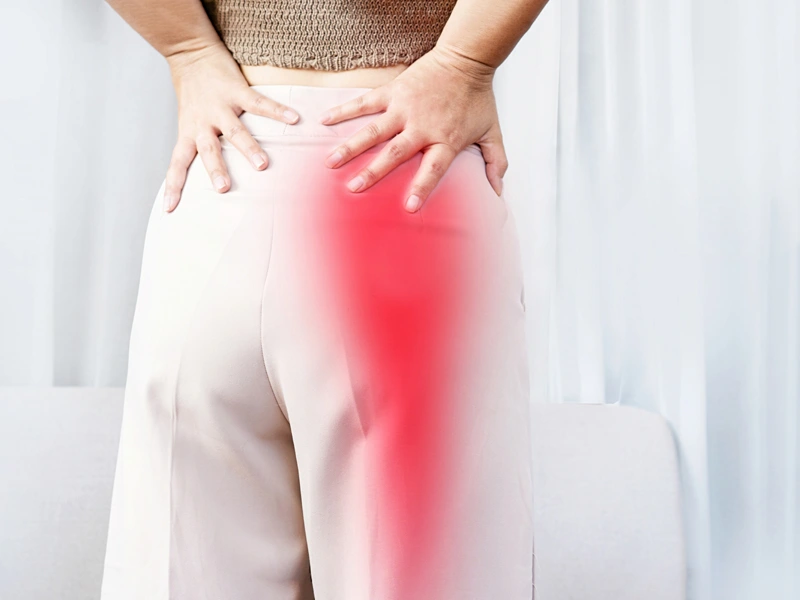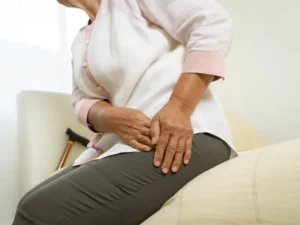In the quiet corridors of daily life, there’s a particular sting that many know all too well—the radiating burn of sciatica, especially when it connects with the hip. It’s not just a pain; it’s an interruption, a persistent reminder that the body is signaling something. For some, it’s a brief and passing twinge, but for others, it’s a relentless ache that merges the back, hip, and leg into a symphony of discomfort. This guide is not only about understanding sciatica’s intimate relationship with hip pain but also about finding pathways to relief, management, and, ultimately, overcoming it. Let’s dive into the depths of sciatica and hip pain, and together, illuminate the road to recovery.
Contents
What is Sciatica? An Overview
Sciatica, more than just a term tossed around in medical circles, is a genuine discomfort felt by many. But what really lies behind this oft-mentioned term?
- Root of the Issue: At its core, sciatica refers to the pain that radiates along the path of the sciatic nerve. This nerve branches from your lower back through the hips and buttocks and down each leg. Typically, sciatica only affects one side of the body.
- Primary Culprit: While many think of it as a condition, sciatica is essentially a symptom. The pain is the result of an underlying issue. Most commonly, this symptom arises due to a herniated disk, bone spurs on the spine, or narrowing of the spine (spinal stenosis), which compresses parts of the nerve.
With this foundational knowledge, we can delve deeper into how sciatica intertwines with hip pain, making daily activities a challenge for many.
The Sciatica-Hip Connection: Why They Interact

The human body is a marvel of interconnected systems, where one part can significantly influence another. This intricate relationship is particularly evident when it comes to the sciatica-hip connection. Let’s break it down:
- Anatomical Proximity: The sciatic nerve, the longest and thickest nerve in the body, runs from the lower back, branches through the buttocks, and continues down the leg. As it courses through, it passes near the hip joint. Due to this close proximity, any irritation or compression of the sciatic nerve can easily affect the hip region.
- Hip’s Role in Movement: The hip joint plays a pivotal role in many of our movements. Walking, bending, sitting, and even twisting involve the hip. When the sciatic nerve is irritated, these everyday motions can exacerbate the pain, making the hip feel like the epicenter of discomfort.
- Referred Pain: Sometimes, the brain can get a bit muddled with pain signals. This phenomenon, known as referred pain, occurs when the pain is felt in a different location than its actual source. For those with sciatica, even if the root issue lies in the lower back or along the nerve’s pathway, the pain can be ‘referred’ to the hip, making it feel as if the hip is the problem.
- Muscle Involvement: Muscles surrounding the hip, like the piriformis, can sometimes spasm or become inflamed due to sciatic nerve irritation. When this happens, the muscle can further compress the nerve, leading to what’s often termed “piriformis syndrome,” a cause of sciatica where the hip’s muscles play a direct role.
In essence, while the hip might seem like an unlikely accomplice to back troubles, its close relationship with the sciatic nerve means that it’s often caught in the crossfire, leading to the dual discomfort of sciatica and hip pain.
Identifying Sciatic Hip Pain: Key Symptoms

- Radiating Pain: A hallmark of sciatica, the pain often starts in the lower back or buttock and radiates down the back of the thigh to the hip and further down the leg.
- Burning or Tingling Sensation: Instead of a dull ache, sciatica-induced hip pain might present as a burning or tingling feeling in the hip area.
- Weakness or Numbness: You may experience muscle weakness in the affected leg or a numb sensation in the hip region, making daily activities challenging.
- Pain on One Side: Unlike general hip discomfort, sciatic hip pain typically affects only one side of the body, aligning with the irritated sciatic nerve’s path.
- Worsened by Sitting: Prolonged sitting can intensify the hip pain, especially if the sciatic nerve is further compressed in this position.
- Sharp, Shooting Pain: When making sudden movements or standing up, the pain can manifest as a sharp, intense jolt in the hip and leg.
- Limited Range of Motion: The discomfort might limit your ability to move your hip freely, making motions like twisting or lifting the leg painful.
- Deep Ache at Rest: Apart from activity-induced pain, sciatic hip pain can sometimes be a deep, persistent ache even during rest or sleep.
By understanding these specific symptoms, it becomes easier to differentiate sciatic hip pain from other hip-related discomforts, ensuring timely and appropriate treatment.
What Triggers Sciatica and Hip Pain?
 Sciatica and hip pain, while closely linked, have a range of potential triggers. Understanding these causes can shed light on the complex relationship between the sciatic nerve and the hip, as well as inform effective treatment strategies. Below are some common causes that can lead to both sciatica and hip pain:
Sciatica and hip pain, while closely linked, have a range of potential triggers. Understanding these causes can shed light on the complex relationship between the sciatic nerve and the hip, as well as inform effective treatment strategies. Below are some common causes that can lead to both sciatica and hip pain:
- Herniated or Bulging Discs: The spinal discs act as cushions between the vertebrae. When a disc becomes herniated or bulges out, it can press on the nearby sciatic nerve, causing pain that radiates to the hip area.
- Piriformis Syndrome: The piriformis muscle lies deep in the buttock, close to the sciatic nerve. When this muscle becomes tight or spasms, it can irritate the sciatic nerve, leading to hip pain and sciatica.
- Spinal Stenosis: A narrowing of the spinal canal, often due to age-related wear and tear, can compress the nerves exiting the spine, including the sciatic nerve. This compression can manifest as pain in both the lower back and hip.
- Spondylolisthesis: This condition occurs when a vertebra slips over the one beneath it, potentially compressing the sciatic nerve and causing pain that extends to the hip.
- Pregnancy: The physical and hormonal changes that occur during pregnancy can put pressure on the sciatic nerve. The added weight and altered center of gravity can contribute to discomfort in the hip region.
- Degenerative Hip Conditions: Osteoarthritis of the hip or other degenerative hip conditions can exacerbate sciatic symptoms due to the close proximity of the hip joint and the sciatic nerve.
Recognizing the root cause of sciatica and hip pain is crucial, as it influences the choice of treatment and potential outcomes. Early diagnosis and intervention can prevent further complications and enhance the quality of life.
Natural Management Techniques for Relief
Managing sciatica and hip pain doesn’t always necessitate medications or surgical interventions. There are a variety of natural techniques that can be effective in offering relief. By understanding and implementing these methods, many individuals find substantial alleviation from their discomfort.
Stretching Exercises

- Sciatic Nerve Glides: This helps improve the mobility of the sciatic nerve. Start seated in a chair. Extend one leg out with the heel on the ground and toes pointing up, then flex and point your foot a few times. Repeat on the other side.
- Piriformis Stretch: Lie on your back with both feet flat. Cross one ankle over the opposite knee and gently pull the uncrossed leg towards your chest. You should feel a stretch in the buttock of the crossed leg.
Posture Corrections
- Mind Your Sitting: Ensure that when you’re sitting, your feet are flat on the ground, and your knees are at a 90-degree angle. Use a lumbar roll or a cushion to support your lower back.
- Standing Posture: Keep your weight evenly distributed on both feet. Avoid locking your knees, and tuck your chin slightly to keep a neutral spine.
Lifestyle Adjustments
- Weight Management: Maintaining a healthy weight can reduce the stress on the spine and hips, potentially reducing the symptoms of sciatica.
- Regular Movement: If your job involves prolonged sitting, ensure you take regular breaks to stand, stretch, and walk around.
- Ergonomics: Ensure your workspace, especially if you’re working from home, is set up to support your spine’s natural curve.
Hot and Cold Therapy
- Cold Packs: Initially, you might find relief from a cold pack placed on the painful area for up to 20 minutes several times a day.
- Heat Therapy: After a couple of days, switch to heat. It can help reduce muscle spasms. You can use a warm towel or a heating pad.
Mind-Body Techniques
- Meditation and Deep Breathing: These can help relax the muscles, which can reduce pain.
- Yoga: Specific poses can help stretch and strengthen muscles, improving flexibility and reducing pain.
Sleep Position
- Opt for a position that reduces the pressure on the sciatic nerve. For many, sleeping on the side with a pillow between the knees can be beneficial.
By integrating these natural management techniques into your daily routine, you can not only experience relief from sciatica and hip pain but also improve overall well-being and prevent future flare-ups.
Alternative Therapies
 When it comes to managing sciatic hip pain, stepping outside the realm of conventional treatments can sometimes provide the relief one seeks. Here are some alternative therapies that have garnered attention:
When it comes to managing sciatic hip pain, stepping outside the realm of conventional treatments can sometimes provide the relief one seeks. Here are some alternative therapies that have garnered attention:
- Physical Therapy:
- Purpose: Tailored exercises and treatments to strengthen muscles, improve posture, and enhance flexibility.
- Benefits: Reduces pain, increases mobility, and prevents future episodes.
- Acupuncture:
- Purpose: Involves inserting thin needles at specific points to stimulate the body’s natural painkillers.
- Benefits: Can offer pain relief and improve nerve function.
- Chiropractic Care:
- Purpose: Spinal adjustments to improve spinal function.
- Benefits: Can relieve pressure on the sciatic nerve and alleviate associated pain.
- Massage Therapy:
- Purpose: Manual manipulation of soft body tissues.
- Benefits: Eases muscle tension, increases blood circulation, and promotes relaxation.
Exploring these alternative therapies under the guidance of professionals can be a valuable step in your journey to find relief from sciatic hip pain.
Conclusion
Living with sciatic hip pain can be daunting, often impacting daily activities and diminishing the quality of life. However, it’s crucial to remember that there’s a myriad of solutions available, both conventional and alternative. Through understanding, management, and timely intervention, you can navigate your way to relief. And remember, if you’re experiencing Back, Shoulder, Knee, Neck, Elbow, Hip, or Arthritis pain, a physical therapist at PhysioMantra can help: Book an online physical therapy session.




